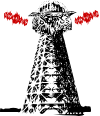Technical information about JJPS Radio
All of our programs are generated automatically; nothing is pre-recorded, with the exception of a few samples here and there. The two main software programs that make this possible are festival, an open-source text-to-speech (TTS) software system, and csound, one of the oldest and widely-used computer music software packages around.
Complete technical information about the programs can be found in the source code, but a brief description of some of our programs can be found below.
Many of our programs use the term-frequency/inverse-document frequency computation (TF-IDF), a measure of the "uniqueness" of a particular word within a dataset. This number is rather coarse, yet it has found wide application within the realm of natural language processing (NLP). Our use of it here is not meant to validate it as a reasonable way to "measure" properties about documents, but rather as a way to model how actual search engines divide up articles into computational chunks.
Conjunctional
We select the "stopwords" in the text; these are words, from a NLP perspective, that are often left out of NLP processes because they are considered "insignificant". Words such as of, and, he, she, it, a, the, etc. We then take a subset of the other words in the text. Then, finally, we go through the text word by word. If a "stopword" is found, it is played straight; if it is one of the other words, it is played backwards; and if nothing is found, nothing is heard.
Copy Hour
The content for this program comes from copyright agreements of journal publishers.
Cut-up Hour
By taking random sentences from each of the texts in the database, we produce a cut-up show that is reminiscent of the works of Allen Ginsburg and John Cage.
Drone
We go through each sentence within a randomly chosen article. Duration of the sounds are based on the number of syllables in a sentence, while frequency is determined by the length of the sentence. The oscilating variations in the sound come from a cut-up version of the TF-IDF scores in the sentence. The instrument was chosen to be reminiscent of the Theatre of Eternal Music.
Genealogies
In this show we take one of the top publishers in the database and, using TTS, read out the journals they have under their control.
Grain Combine
We take the top words as ranked by TF-IDF and convert them by TTS to sound files. Then we cycle through the text and where the word occurs, subject it to granular manipulations. If there is no matching word, we play a haunting granular manipulation of a sine wave. The otherworldy sounds come from mismatched sampling rates; the TTS files are at 16000kHz, while the final composition is at 44100kHz.
News
The news show searches for the latest stock quotes and headlines of the biggest academic publishers.
Noise
By simply opening our binary database files and writing them out again as sound files, we get a noise landscape.
Open Access Hour
These documents are TTS versions of open-access articles in our database. Our main sources are Culture Machine, Fast Capitalism, and the International Journal of Zizek Studies.
Phasor. mod. freq.
First, we take the number of syllables of each word and, multiplied by a scaling factor, create a rhythmic background. Next, frequencies of the overlaying sounds are determined by word length, with the instrument phase-based FM synthesis.
Recitation Hour
The show that provided the impetus for the entire JJPS project, this is simply TTS of one of the articles in our database. Be sure to checkout the playlist for the show.
Telegraph
This explanation has been removed.
What's the Frequency Kenneth?
Here we count the number of times a word occurs in the text, rank it by size, and read it out. We refer here to the various poetic experiments of Kenneth Goldsmith.
